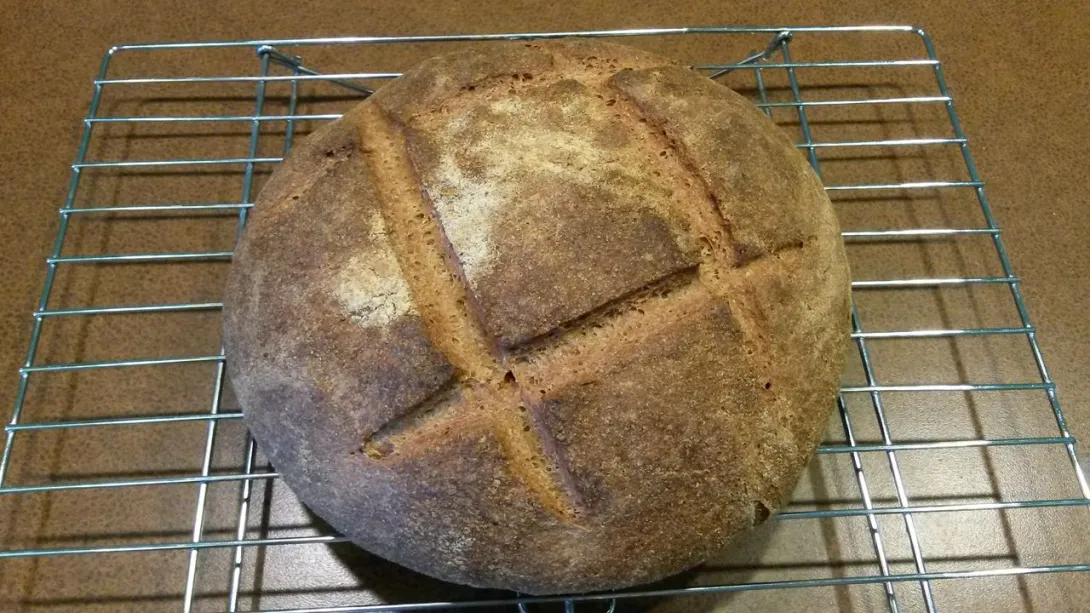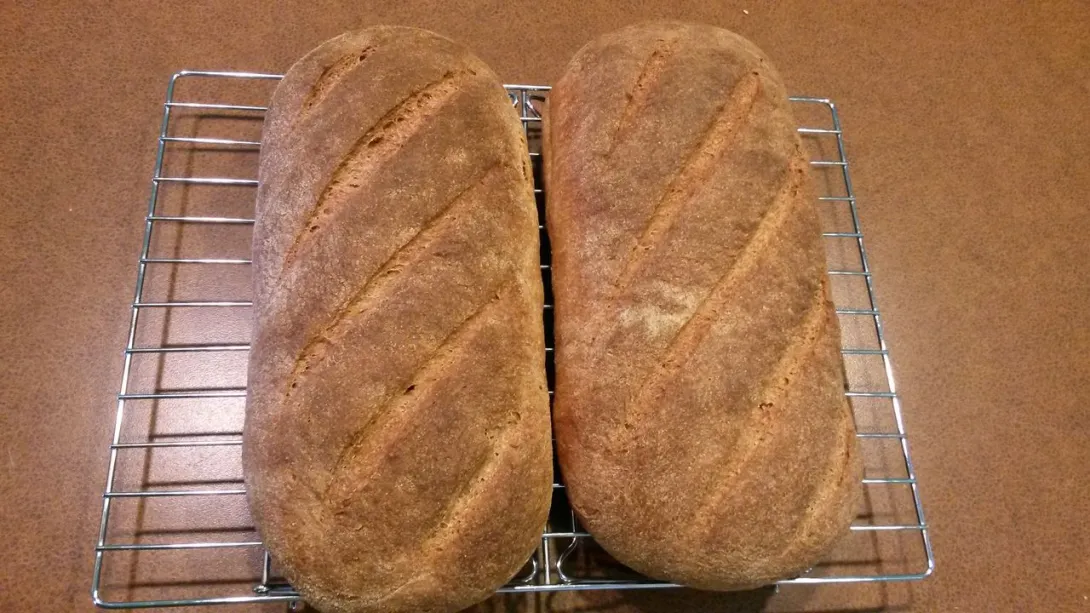
Hi all,
I have just begun to experiment with wheat (I am normally a gluten free baker) and--being a purist and a proponent of whole grains--I have set my sights on 100% WW breads. Of the people I know that like to bake bread, I only know one that knows what a "preferment" is and when I use the word "autolyse" or even "soaker" I lose them too. So I thought I'd post some pics here and try to get some feedback from you more serious bakers.
I bought and am thoroughly enjoying Peter Reinhard's Whole Grain Breads and the three attempts I have made at WW bread have been based on a recipe from this book.
For my first try, I made a poolish according to the instructions in Crust and Crumb and adapted the 100% WW Hearth Bread recipe in WGB to work with this preferment. I didn't get a pic of the crumb, but it was not really worth taking a picture of. It was very dense (even compared to the other two, which also seemed dense to me)

As you can see, it got a little oven spring, but not quite what I was going for.
Next, I made the recipe exactly as PR wrote it.


This time, I got about the same oven spring, but the crumb was a little nicer. Smallish hole size, but a bit irregular and the bread seemed to have a lighter overall texture. Both this loaf and the two before were 100% WW at 70.5% hydration according to PR recipe.
Next, I deviated from the recipe a bit more, since everything I've read on here seems to indicated that more hydration is better for whole grains.


This time, I scaled the recipe up a bit to make two medium batards, as well as upped the hydration to 86%. I made a poolish preferment (100% hydration and 0.6% yeast) and let it rise 4 hours before mixing into the rest of the dough (soaked 16 hours with salt at room temp). Two quick bulk ferments, one final proof and into a 500F oven on a cheap pizza stone with plenty of steam. Got a slightly better oven spring, but the crumb is still so tight.
Any pointers from those veteran WW bakers out there? I have read several posts and it seems that my hydration could even be upped more. Plus, I obtained a lovely sourdough starter from a neighbor that is about ready to be used. I have also looked into sprouting...
**Edit: I thought I should also note that the five different families that I gave these loaves to all said that the flavor was excellent for whole wheat. No bitter after tastes, just a wonderful, sweet, nutty bread flavor. Also none of them seemed under or over cooked to me. All were taken out of the oven when the internal temp registered 200F**
Any thoughts are appreciated.
Daniel
PS- I appologise for the bad pictures. Right now my phone is my only camera.
Daniel, I have had some success using the epoxy method from the Reinhart book. I use home milled whole wheat flour, which means it does not directly compare. My best tip is to keep notes, especially hydration, I find that I make changes and keep track of how they change the loaf.
I have heard that using fresh, home milled flour makes a significant difference in the loaf, but have not yet tried it. Some friends of mine have a mill (the ones that gave me the piece of WW starter), as well as the people that I house-sit for. I'm looking forward to trying it.
As for the milling: any tips? I haven't even begun to search on here for info on milling grain. I have milled some millet (lol, I always love using mill and millet in the same sentance. I got some millet and now I'm going to mill it!) and was very pleased with its effect on my GF bead.
I make a similar loaf, and I generally use 100% hydration each time. It sounds crazy, but it really does absorb a lot more water than white flour.
My loaves generally look similar to yours, but I routinely use a weak starter, as I am to impatient/lazy to refresh it each time I need to use it. When I have used a very active starter, and allow my loves to proof completely, I get a nicer crumb. I've never came close to the open structure that you get with white bread, but it's still pretty nice.
If you do increase hydration, I'd love to see more pictures!
Thanks for the heads up, camerjon.
I remembered reading one of dabrownman's posts about a 100% WW loaf at 100% hydration. That loaf was 50% sprouted wheat though, so I hadn't considered going quite that high with non-sprouted WW flour. Sounds like maybe I should try it.
My starter seems pretty lively. Per the instrutions given to me by my neighbor, I feed it every day. Since she only gave me a cup of the mother, she recomended reeding 1/4 cup each of WW flour and water (comes out to roughly 150% hydration) until it gets a little bigger.
only use whole wheat, bobs red mill. I think whole wheat loaves can pop and spring and be open just like white flour, I don't believe the myths. For sourdough your starter has to be on point, super active and in high rise when pitching into the dough, the autolysed dough. Make fermentation quick, two hours and get shaping and baking. With whole wheat you need to catch it during its peak work or else it can be lost. You also don't need high hydration for a nice spongy product. I regularly use 75%, depends on the type of loaf though. You can get big, oven springed loaves from all whole wheat, just gotta watch the culture closely.
Here is what is possible from an amateur like me:
Very light and open focaccia
Those are the type of loaves I am aspiring to make. Seeing those pictures gives me an idea of what is possible with 100% whole grain breads.
Thanks for the encouragenment, Natyam!